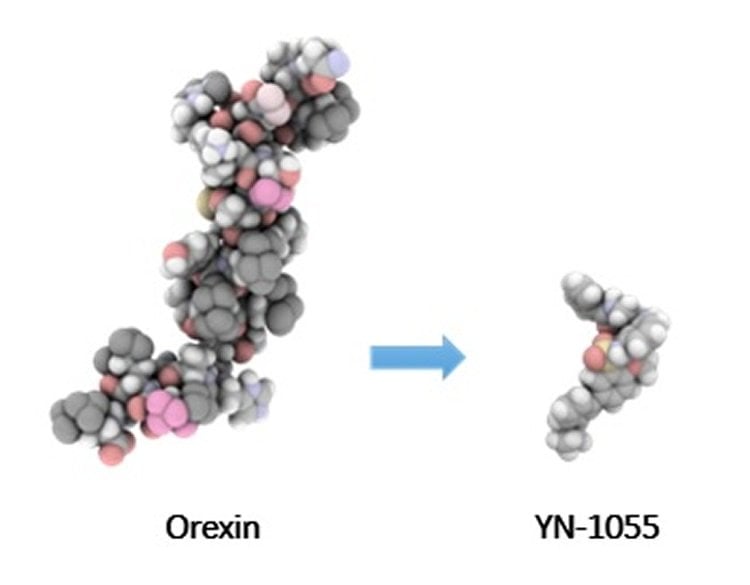Hiroshi Nagase, a Professor at the International Institute for Integrative Sleep Medicine (WPI-IIIS), University of Tsukuba, collaborated with Masashi Yanagisawa (Professor / Director of WPI-IIIS) and successfully developed a potent compound that promotes wakefulness and remedies the sleep disorder narcolepsy in model animals. Their work was published as the “Featured Article” in Journal of Medicinal Chemistry.
“Our achievement opens up a realistic avenue towards a novel medicine for narcoleptic patients. Immediately after our paper was published online, a narcoleptic patient in the US emailed us a letter of appreciation, which gave us further motivation to tackle this difficult technical challenge. We will make our best effort to keep optimizing the compound so that we will be able to provide a cure for narcolepsy in the near future.” Nagase says.
The compound works to mimic the action of a wake-promoting substance in our brain called “orexin.” Orexin, discovered in 1998 by Yanagisawa, is a neuropeptide that plays a central role in maintaining wakefulness. Its deficiency causes a serious sleep disorder called narcolepsy, in which patients experience excessive daytime sleepiness, often falling asleep uncontrollably. Patients also suffer from symptoms such as cataplexy (sudden loss of muscle tone triggered by emotion), vivid hallucinations when going into or out of sleep, and sleep paralysis. Orexin itself is proven to be effective in improving narcoleptic symptoms in model animals, but it cannot be readily used as a medicine because the blood-brain barrier (BBB) prevents it from entering the brain, where orexin works by binding to its receptors. Instead, a small molecule mimicking orexin (orexin receptor agonist) should be useful as a therapeutic agent for narcolepsy.

Nagase and his colleagues designed and synthesized more than 2,000 compounds, and eventually discovered the first non-peptidic orexin receptor agonist, YNT-185. Giving YNT-185 to normal mice strongly promoted wakefulness. Moreover, YNT-185, when given to narcoleptic model mice, significantly ameliorated the symptom (unpublished data). This achievement is an important first step for development of a novel medicine to correct the fundamental disease mechanism of narcolepsy.
Source: University of Tsukuba
Image Credit: The image is credited to the researchers
Original Research: Abstract for “Design and Synthesis of Non-Peptide, Selective Orexin Receptor 2 Agonists” by Takashi Nagahara, Tsuyoshi Saitoh, Noriki Kutsumura, Yoko Irukayama-Tomobe, Yasuhiro Ogawa, Daisuke Kuroda, Hiroaki Gouda, Hidetoshi Kumagai, Hideaki Fujii, Masashi Yanagisawa, and Hiroshi Nagase in Journal of Medicinal Chemistry. Published online November 17 2015 doi:10.1021/acs.jmedchem.5b00988
Abstract
Design and Synthesis of Non-Peptide, Selective Orexin Receptor 2 Agonists
Orexins are a family of neuropeptides that regulate sleep/wakefulness, acting on two G-protein-coupled receptors, orexin receptors 1 (OX1R) and 2 (OX2R). Genetic and pharmacologic evidence suggests that orexin receptor agonists, especially OX2R agonist, will be useful for mechanistic therapy of the sleep disorder narcolepsy/cataplexy. We herein report the discovery of a potent (EC50 on OX2R is 0.023 μM) and OX2R-selective (OX1R/OX2R EC50 ratio is 70) agonist, 4′-methoxy-N,N-dimethyl-3′-[N-(3-{[2-(3-methylbenzamido)ethyl]amino}phenyl)sulfamoyl]-(1,1′-biphenyl)-3-carboxamide 26.
“Design and Synthesis of Non-Peptide, Selective Orexin Receptor 2 Agonists” by Takashi Nagahara, Tsuyoshi Saitoh, Noriki Kutsumura, Yoko Irukayama-Tomobe, Yasuhiro Ogawa, Daisuke Kuroda, Hiroaki Gouda, Hidetoshi Kumagai, Hideaki Fujii, Masashi Yanagisawa, and Hiroshi Nagase in Journal of Medicinal Chemistry. Published online November 17 2015 doi:10.1021/acs.jmedchem.5b00988






